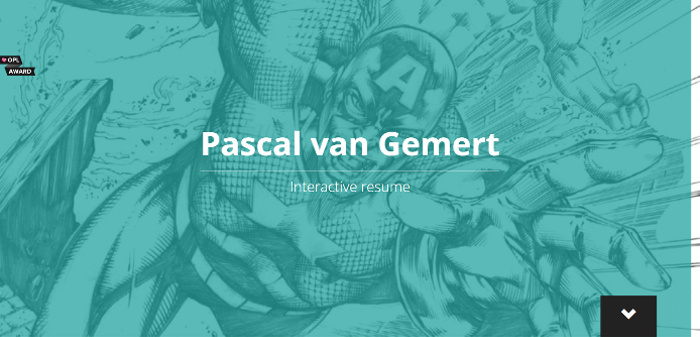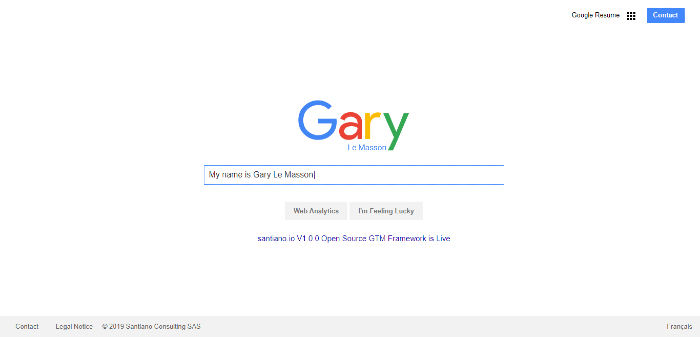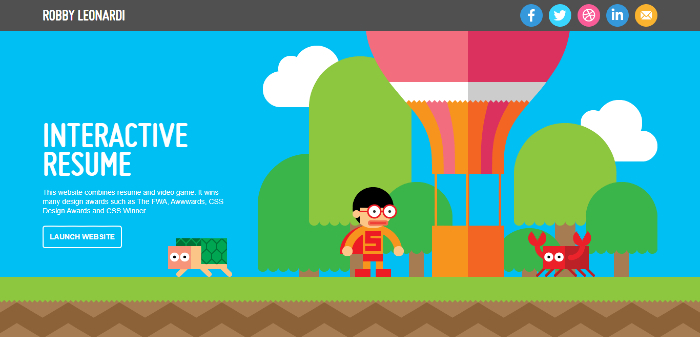You’ve got a shining print résumé, but what about a CV or résumé website?
Well, I don’t need one.
Wrong.
Though a traditional résumé will always be useful in your job search, it is quickly becoming outdated in the modern world where everything has gone online. And if you really want to stand out from the crowd, building a résumé website is your best bet.
Okay. So, how do I go about creating one?
We’ve got you covered! This guide will walk you through everything you need to know about résumé websites, from what they are and what to include, to steps to setting up your site and examples for inspiration.
What is a résumé website?
A CV or résumé website is essentially a digital version of a traditional résumé. Just like the print version, it provides a clear presentation of your background, skills and accomplishments as a way of introduction to potential employers, but in the form of a website.
A résumé website, meanwhile, is not to be confused with a résumé builder website. Whereas a résumé website is self-designed and a type of résumé format, a builder website is essentially an online tool that allows you to create a résumé using pre-made templates, which you then download (typically as a Word or PDF file) to use in your job search.
Résumé websites vs personal websites
For the most part, a résumé website and a personal website are essentially the same thing. They’re both used to introduce yourself and your brand to online audiences. But there are some key differences.
Firstly, CV/résumé websites are specifically geared towards potential employers, and are used to showcase your skills, qualifications and experience, just like a traditional résumé. While personal websites can also be used to market yourself as a jobseeker, they’re generally used for networking purposes or for converting site visitors into subscribers, readers or customers.
Perhaps the biggest difference, though, is the content. Though a personal website might provide information about the owner’s background, it generally focuses on image and video displays of their previous work and the services that they offer. A résumé website, on the other hand, is more text-based, and provides a detailed rundown of the owner’s work history, educational background and skills.
When to use a résumé website
A résumé website comes in handy in many situations, particularly when you’re:
- Looking for a job (whether actively or passively)
- Changing careers
- Looking for freelance opportunities
- Establishing yourself as a professional consultant in your field
- Establishing your online presence
That said, résumé websites are especially useful for creative professionals (like actors, musicians, photographers and writers) and all sorts of freelancers, as it helps them effectively market their technical skills and showcase their work to potential employers.
Benefits of a résumé website
There are many benefits to creating a résumé website:
- You keep up with the times. Everything and everyone is online these days. By creating your own résumé website, you show potential employers and clients that you’re tech-savvy — an essential quality in today’s technology-focused world. Ultimately, it gives you an edge over the competition.
- It makes you more discoverable. You don’t have to be actively searching for jobs to come across opportunities. In fact, a well-written, SEO-driven website has the power to attract employers and recruiters searching for the skills you possess.
- You can cover your background more extensively. While traditional résumés are limited to 1–2 pages in length, a website allows you to expand on your skills and achievements in greater detail and, ultimately, provides a more rounded picture of your personality, preferences and abilities.
- It’s more dynamic than a traditional résumé. There’s so much more you can do with a résumé website than a paper version, like adding multiple links to different sections of your site, companies you’ve worked for and published work, as well as adding photos and graphics.
- It’s easily shareable. You can share your website anywhere — on your résumé, in your email signature and on your social media profiles. You can even share a link to your website to potential contacts you meet in person — chances are, after all, that you won’t be carrying your print résuméwith you everywhere you go.
What to include
At the very least, your website should include:
- A homepage featuring catchy introductory material — this should serve as a table of contents of sorts to your site’s sections.
- An about or bio page, offering visitors a summary of who you are and what you do.
- Dedicated pages for your work history, education and skills and, optionally, awards, publications, testimonials and any other useful information.
- Your contact details — if you’re worried about your information being publicly available on the internet, consider setting up a dedicated email address and getting a second phone number for professional purposes; it’s also a good idea to add a contact form connected to your email address.
- Links to your LinkedIn and social media profiles so that employers can connect with you — this also helps you better establish your digital presence.
- A professional photo — this means no distracting selfies, snaps from an alcohol-infused night out, wedding photos or anything else that could hinder your professional image and, as a result, candidacy for job opportunities.
- An optional blog where you can share your expertise and thought leadership.
- An optional portfolio highlighting your skills and best work.
- A download link to your résumé — make sure you save your document as a PDF file so that it can be read across different computers and so its layout and fonts are maintained.
How to create a résumé website
Now the juicy part: how to make (and setup) your CV or résumé website. Here are the steps you’ll need to follow.
Step 1: Choose a method that’s right for you
There are three main options to choose from to build your website:
- Create it from scratch: If you have the coding skills, creating your résumé website from scratch is encouraged, as it effectively demonstrates those skills and your technical knowhow to potential employers. This also gives you complete control over its look and functionality.
- Use a website builder: If you’re not very web-savvy but you still want to try your hand at creating your website yourself, website builders and hosts like Wix and WordPress.com are a great option. Though they provide limited creative freedom, their convenient drag-and-drop editors will help you get your site up and running in next to no time.
- Hire a professional: This option is perfect if you don’t have the time or knowledge to create a DIY website — provided, of course, that you have the budget. Prices generally vary between $500 and upwards of $25,000 and depend on a variety of factors, including the number of pages, the complexity of design and development, and who builds your website (ie: an independent designer vs an agency).
Step 2: Choose a design
Next up is selecting a design for your website, which should be simple, clean, modern and user-friendly.
When choosing a design, make sure to consider the material you’ll present on your website and the best layout for this. For example, if you want a less-is-more approach, a one-page design is the way to go, but if you have a lot of information you want to cover, then a multi-page design works better.
If you’re using a website builder, you’ll be able to choose from a wide variety of templates based on your needs. You can also upload third-party templates from foundries like Theme Forest and WooCommerce, though you will typically need a premium plan with your chosen website builder for this.
PRO TIP
Make sure the look of your print résumé and your website are uniform. This is essential for creating a consistent personal brand, which makes you instantly recognisable.
Step 3: Register a unique domain name
When setting up your résumé website, you’ll need to register a domain name for it. This should be unique, memorable and easy to type.
Though johnsmithisthebestwebcontentwriterintown.com is arguably unique and somewhat memorable, it’s for all the wrong reasons — and it certainly isn’t easy to type. Something like johnsmith.com or johnsmithwriter.com, on the other hand, ticks all the right boxes.
If you use a website builder, you’ll typically have the option to register a domain name for your site, either as an add-on or as part of your selected plan. Otherwise, you can use a domain name registrar like GoDaddy or Domain.com.
Step 4: Choose and organise the sections
Once you’ve got all the technicalities out the way, it’s time to start planning your website’s structure — specifically, the sections it will include. Generally speaking, you should create an individual page for each section of your print résumé, as well as a homepage and optional blog and portfolio. (If you’re using a one-page design, all this information should be clearly divided into relevant sections.)
Make sure you add a menu with links to each section so that visitors can easily navigate to the appropriate information, and that sections are organised in a way that helps you tell your story and share your professional journey.
PRO TIP
Give each page an appropriate name and URL slug (the unique identifying part of a web address, for example: https://www.careeraddict.com/about).
Step 5: Write the content
One of the great things about a résumé website is that its content doesn’t have to sound as mechanical as your print version. Whereas a résumé requires more concise and technical language, a website affords you the opportunity to expand on your background in a more human way through effective storytelling. You can even incorporate personal anecdotes and inject some humour into your content to make it more engaging and show off your personality (keep it PG, though).
Ideally, each page should be a minimum of 300 words long. That said, it’s likely some pages will be significantly shorter (like the contact page), and that’s okay. The important thing to remember when writing your site’s content is to make sure it offers value to readers — quality, after all, is far better than quantity.
PRO TIP
Make sure your website isn’t full of pages with just text — this can get boring fast. Find ways to visualise your skills and accomplishments (through graphs, for example), add appropriate images (including a photo of yourself), and consider creating a logo.
Step 6: Optimise your website for search and mobile devices
One thing to keep in mind when building your résumé website is to make sure it’s search engine and mobile-friendly. Here are some things you can do to achieve this:
- Incorporate relevant keywords within your site’s content
- Use appropriate heading structures
- Add site metadata (meta titles, descriptions and keywords)
- Use descriptive alt text for any images you include
- Choose a responsive design for your site
If you’re using a website builder, meanwhile, make sure to check what tools and resources they offer to help you optimise your site.
7. Publish your website and track the results
Now that you’ve got everything done, all that’s left for you to do is to publish your website. (Be sure to go over it first to correct any typos, formatting issues and inaccuracies — it’s also a good idea to share your website with family and friends for their feedback.)
Once you’ve published your website live on the web, make it a point to actively monitor site traffic (particularly in terms of page views, how visitors found your site and where visitors are based) and the effectiveness of the keywords you’ve used through web analytics tools, like Google Analytics. This will help you determine what’s working and what isn’t and adjust accordingly.
8. Update it regularly
Like your traditional print résumé, your résumé website should be updated regularly to reflect any new skills, experiences, projects and achievements. This ensures that it doesn’t become outdated and that it leaves a better overall impression on visitors.
This is also good for SEO — the more frequently you update your site, the more frequently search engines like Google will visit your site and re-evaluate your page ranking.
Meanwhile, if you decide to add a blog section to your website, it’s important that you’re willing to dedicate a lot of time and effort to publishing new content for better results. One post per week or even month is fine, though Neil Patel suggests publishing at least three posts per week if you want to make money from your blog.
Résumé website examples
Need some inspiration for creating your own résumé website? Check out these awesome examples below!
Pascal van Gemert

One of the many great things about Pascal van Gemert’s one-page résumé website is how it effectively captures his personality — from the Captain America background on the page intro to the famous quotes interspersed between sections. The Dutch PHP web developer even asks visitors who copy his site’s design to make a donation and effectively buy him a beer!
Van Gemert’s website isn’t only clean and beautifully designed, but it’s also user-friendly, complete with a handy sticky sidebar navigating visitors to the profile, experience, skills, projects and contact sections.
Gary Le Masson

Gary Le Masson has designed his website to look like Google’s interface — quite fitting for a web analytics consultant!
Using Drupal, Le Masson has created four separate sections for his website:
- Web Analytics, where he describes his work and expertise
- References, which details the companies he’s worked with
- Google Resume, which displays his skills, experience and more as a Google search results page
- Contact, which contains a contact form and his contact details
Le Masson’s website comes complete with a Google Knowledge Graph (containing personal details like his age, height and location), links to his social media accounts and a Google-inspired Gary logo.
Robby Leonardi

New York City-based illustrator, designer and animator Robby Leonardi’s interactive résumé website has been getting the attention of employers and retro game lovers alike since it was first launched in 2013. It’s also been featured in the likes of USA Today, Business Insider and Mashable, and it’s won numerous design awards, most notably from Awwwards and the FWA.
Leonardi’s Super Mario-inspired website is both impressive and memorable, as you ‘play’ through different levels as cartoon Robby to view his experience, skills, qualifications, publications and interests. At the end, ‘players’ are invited to send Leonardi a message and connect with him on social media.
Final thoughts
Some parting advice for building a résumé website is that it should complement — not replace — your print résumé. You’ll always be asked to submit your print CV or résumé when applying for a job, after all, and most companies won’t even ask you for the digital version during the application process. That said, if you do create a website, make sure to include a link to it in your paper version.
Got a question? Whether you're deciding which website builder to use or you're not quite sure how to write your site's content, we're here to help. Just drop us a comment below!


